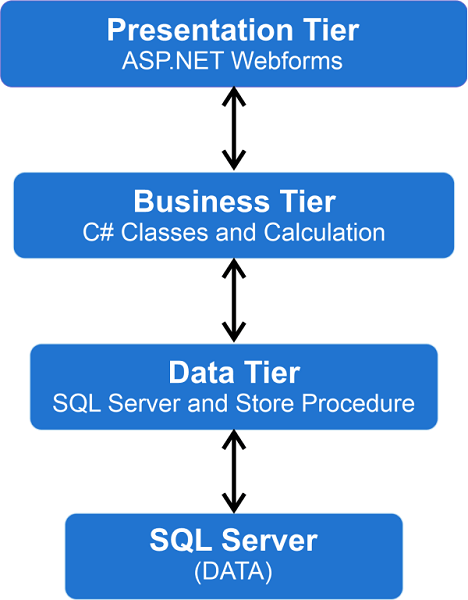3-tier architecture in c#This article briefly discusses the three-tier application in c#. A three-tier architecture divides the project into three layers: the user interfaces layer, the business layer, and the data (database) layer, and separates the UI, logic, and data into three layers. If a user wants to change her UI from Windows to Phone, she can change the UI layer, and the other layers will not be affected by this change. Otherwise, everything remains the same. 
Why do we use 3 tier application on any project?We use a three-tier structure to control large projects. For instance, let us say you wrote 2000 entity codes and coded all the code in a single layer. Say you want to interchange between home windows software and cellular or web applications, and you must rewrite the code for all 2000 entities. You must trade the database connection for all 2000 entities if you change the database provider. Increase. So, writing a lot of code wastes money and time. Additionally, writing numerous codes in layers makes it difficult for new humans to apprehend them. Therefore, a project should use a three-tier architecture to provide maintenance, flexibility, update, and clean and understandable code without affecting other parts. So, we use 3-tier architecture because of these points -
What is the difference between layer and tier? Layer and tier are often used interchangeably, which is incorrect. The main difference between layers and layers is how they are organized. In contrast, a tiered architecture divides an application into many physical entities on separate infrastructures. Another difference arises from the responsibility of the lowest-level component of each architecture. The data access layer does not provide data, so most of the time, the data resides in the application layer (some designs are separated into one layer). In this view, one level can contain multiple levels. For example, a mobile phone camera application is n-tier. It is also called a single-tier application because all the processes run on the phone. Presentation Layer: The user interacts with the app to capture images. Data Access Level: Apps access device memory to store processed information. What are the three parts of the three-tier architecture?The three-tier architecture includes three tiers, these are - 1. Presentation Tier:That is the pinnacle layer of architecture. The top software layer is the personal interface. It is related to her UI. This is displayed to the consumer. The primary feature of this degree is to translate responsibilities and consequences into something the consumer can understand. This includes pages that include net forms, windows bureaucracy, etc., where records are displayed to the consumer and used to acquire input from the user. The presentation layer is the most vital because the person sees it, and an excellent consumer interface draws the consumer, and this deposit needs to be well designed. 2. Business Tier:This is the middle tier of the structure. This residue contains C# lessons, and logical calculations and operations are completed below this layer. It also acts as a middleware among the surrounding layers, the presentation, and the facts tiers. Procedure records between those layers. This residue implements good business judgment and calculations. This layer also validates input conditions before calling methods from the data layer. This ensures that the data input is correct before proceeding, and in many cases, the output is also correct. This input validation is called a business rule. 3. Data Tier:This tier connects the business tier to databases or data sources. Consists of strategies used to carry out operations on the database, including insert, delete, and update. This residue consists of saved approaches used to query the database. So, this residue connects to the database and performs capabilities on the database. Application of 3 tiers using C#:This is the heart of the 3-tier architecture and the most complex and difficult implementation layer. So, you need an excellent design to manage and organize your code. Therefore, we used a 3-tier architecture for this tier. This level does not interact with the user. Interact with other layers/applications. In other words, the presentation layer (application layer) is not the user interface. What are the advantages and drawbacks of 3-tier architecture?Advantages:
Drawbacks:
Next Topic#
|
 For Videos Join Our Youtube Channel: Join Now
For Videos Join Our Youtube Channel: Join Now
Feedback
- Send your Feedback to [email protected]
Help Others, Please Share










